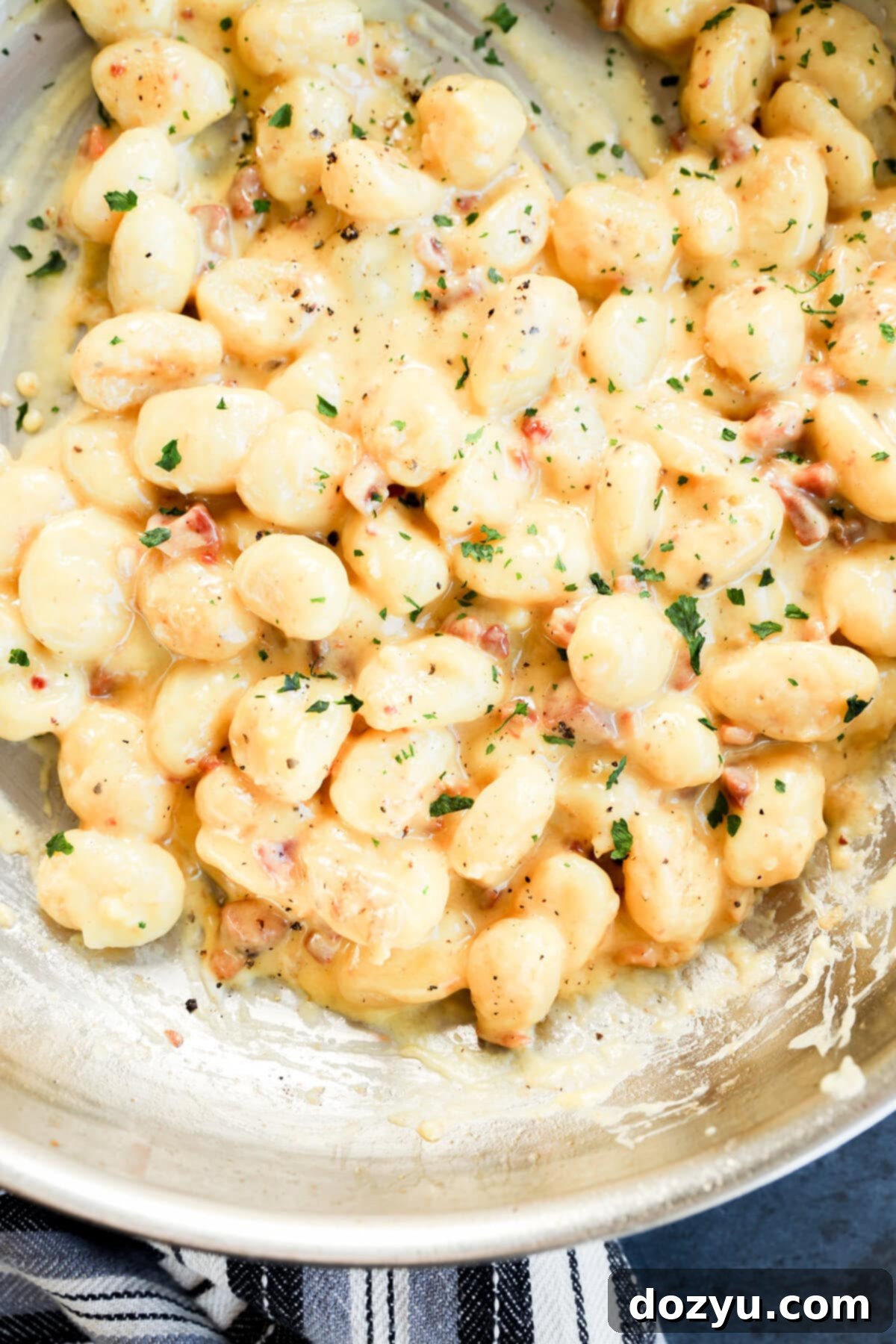Ultimate 30-Minute Gnocchi Carbonara: A Deliciously Creamy Italian Twist
Indulge in a quick and satisfying meal with this exquisite Gnocchi Carbonara recipe. We’re taking the beloved Roman classic and giving it a delightful twist by swapping traditional spaghetti for tender, pillowy potato gnocchi. The result is a comforting, rich, and intensely savory dish that comes together in under 30 minutes, proving that gourmet flavors don’t have to be complicated. With just a handful of high-quality ingredients, you can elevate your weeknight dinner routine and impress your palate.
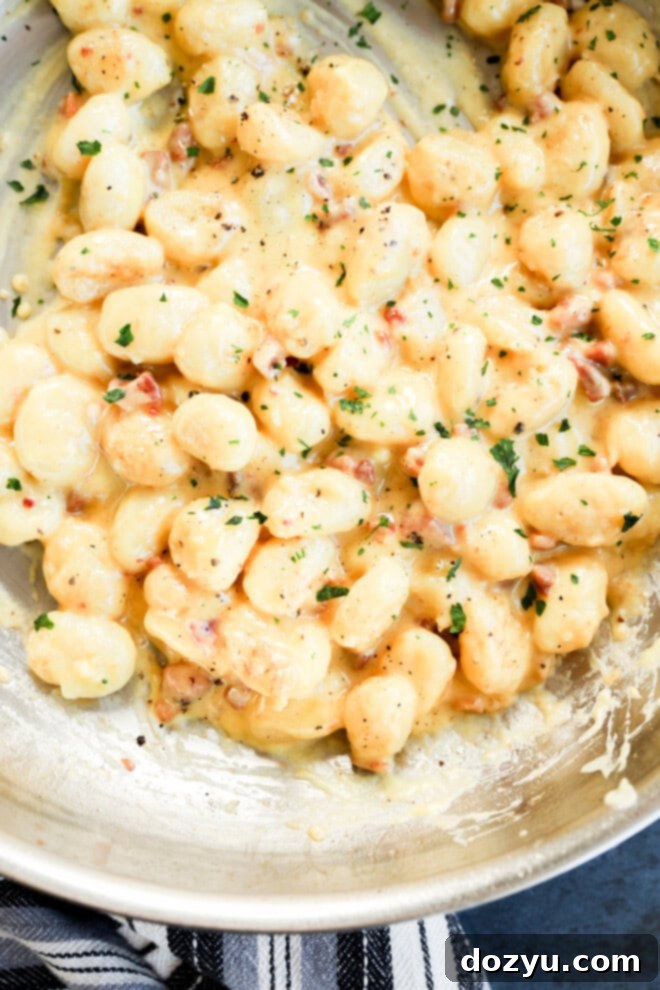
Table of Contents
About This Gnocchi Carbonara
Carbonara holds a special place in the heart of Italian cuisine, celebrated for its incredible depth of flavor derived from surprisingly simple ingredients. It’s a testament to the power of fresh eggs, hard cheese, cured pork, and black pepper, transformed into a luxuriously creamy sauce without a drop of actual cream. In this rendition, we’re pushing the boundaries of tradition by embracing pillowy potato gnocchi instead of spaghetti, offering an exciting textural contrast and a heartier bite that makes this dish truly unique.
If you’ve ever been intimidated by classic Italian cooking, this Gnocchi Carbonara is the perfect starting point. The method for creating the luscious carbonara sauce might seem daunting at first glance, but it’s remarkably straightforward once you understand the technique. The magic lies in the emulsion: combining tempered eggs, finely grated cheese, and a splash of starchy pasta water to create a glossy, velvety coating that perfectly clings to each tender gnocchi dumpling.
This dish is more than just a meal; it’s an experience. The crispy, salty pancetta renders its fat, providing a foundational layer of savory richness. This fat then coats the gnocchi, infusing every piece with incredible flavor before being embraced by the silky carbonara sauce. The result is a symphony of textures and tastes—crisp, tender, creamy, and savory—all harmonizing in one skillet. It’s a hearty, flavorful, and profoundly satisfying meal that feels gourmet, yet is entirely approachable for any home cook. Serve it alongside a crisp green salad or some warm, crusty bread, and you’ll have a complete dinner that’s both elegant and deeply comforting.
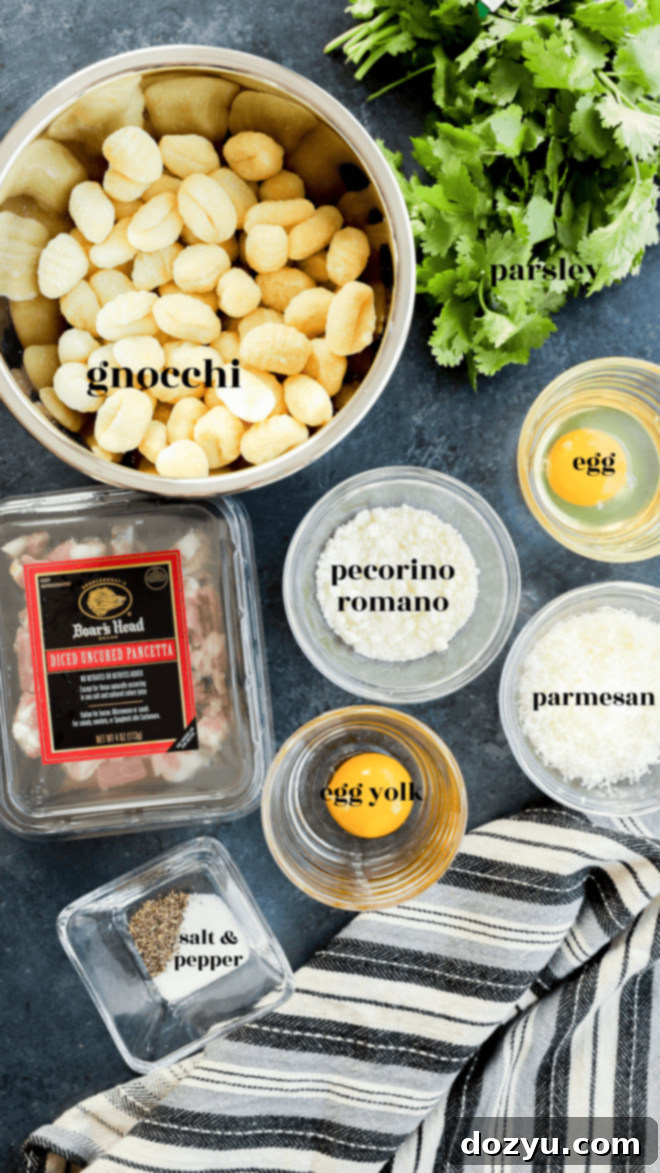
Key Ingredients for Gnocchi Carbonara
The beauty of Carbonara lies in its simplicity, requiring only a few high-quality ingredients to achieve profound flavors. Here’s a closer look at what you’ll need:
- Pancetta: This cured Italian pork belly is the cornerstone of authentic carbonara. When cooked, it becomes wonderfully crispy and renders a flavorful fat that’s essential for the sauce. This fat not only adds incredible depth but also helps coat the gnocchi, ensuring every bite is irresistible. If true pancetta is hard to find, a good quality, thick-cut bacon, roughly chopped, can serve as a suitable substitute, though it will impart a slightly smokier flavor.
- Black Pepper: Freshly coarse ground black pepper is non-negotiable. Its bold, pungent, and aromatic kick provides a crucial counterpoint to the richness of the cheese and pork, elevating the entire dish. Do not use pre-ground pepper, as its flavor is far less vibrant.
- Potato Gnocchi: These tender, pillowy potato dumplings are our star ingredient, offering a unique texture that differentiates this dish from traditional pasta carbonara. Gnocchi readily absorbs the rich, creamy sauce, making each morsel a burst of flavor. You can use either shelf-stable or refrigerated gnocchi for convenience.
- Kosher Salt: Use salt judiciously. Pancetta is naturally very salty, so your primary use of salt should be to properly season the water for cooking the gnocchi. A little extra for final seasoning can be added to taste, but always err on the side of caution.
- Eggs: The heart of the carbonara sauce. This recipe calls for one whole large egg and one large egg yolk. The yolk provides a luscious richness and deep yellow hue, while the whole egg helps bind the sauce, ensuring it emulsifies beautifully and clings perfectly to the gnocchi. For best results, allow your eggs to come to room temperature before mixing to prevent scrambling when added to the warm gnocchi.
- Cheese: A blend of two distinct Italian hard cheeses creates a complex, irresistible finish. Sharp, tangy Pecorino Romano contributes a robust, salty flavor, while nutty Parmesan (Parmigiano-Reggiano) adds a milder, more rounded depth. Freshly grated cheese is paramount here; pre-grated varieties often contain anti-caking agents that can hinder smooth melting and affect the sauce’s texture.
- Fresh Herbs (Optional): While not strictly traditional, a sprinkle of freshly chopped parsley or chives adds a welcome touch of brightness and a pop of color to the finished dish. It’s a simple garnish that can lift the overall presentation and provide a subtle fresh note.
Essential Kitchen Tools for Gnocchi Carbonara
Having the right equipment at hand can make your cooking experience seamless and ensure the best results for your Gnocchi Carbonara. Here are the must-have tools:
- Nonstick Skillet or Cast-Iron Skillet: A large, heavy-bottomed skillet is crucial. A nonstick pan ensures your gnocchi doesn’t stick and the pancetta crisps evenly without burning. A cast-iron skillet, with its excellent heat retention, is also a fantastic choice, allowing you to achieve a beautiful crisp on the pancetta and maintain the residual heat needed for the sauce.
- Large Pot: Essential for boiling the gnocchi. Make sure it’s large enough to give the gnocchi plenty of room to cook without clumping together.
- Wooden Spoon: An invaluable tool for stirring ingredients gently, especially when making the sauce. A wooden spoon won’t scratch your cookware and helps to incorporate the egg mixture smoothly into the gnocchi without scrambling.
- Sturdy Mixing Bowl: You’ll need this to whisk together your eggs and cheeses for the carbonara sauce. A bowl that’s wide enough for easy whisking is ideal.
- Chef’s Knife and Cutting Board: For safely and efficiently dicing your pancetta and chopping any fresh herbs for garnish.
- Spider Strainer or Slotted Spoon: These tools are perfect for gently scooping the delicate gnocchi out of the boiling water and transferring them to the skillet without damaging their tender texture.
- Whisk: To ensure your egg and cheese mixture is perfectly smooth and well combined before it’s added to the gnocchi, preventing any lumps or separation.
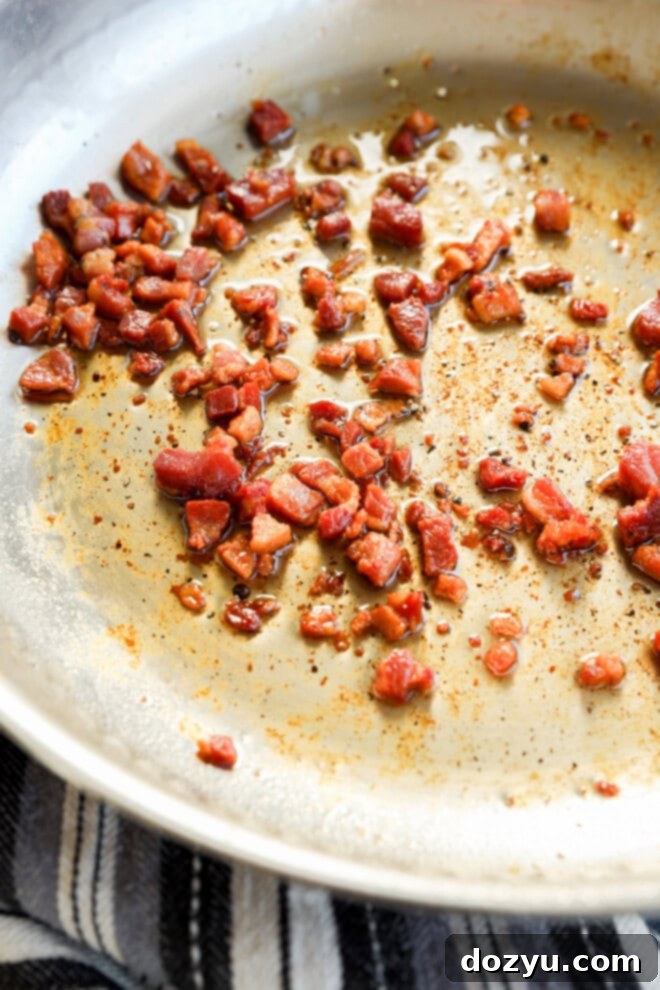
How to Make This Gnocchi Carbonara
Creating this Gnocchi Carbonara is a delightful process that’s surprisingly quick and rewarding. Follow these steps for a perfect, creamy, and flavorful dish:
Prep and Crisp the Pancetta
Begin by bringing a large pot of generously salted water to a rolling boil over medium-high heat. While the water heats, take your large nonstick or cast-iron skillet and place it over medium heat. Add the diced pancetta to the dry skillet. Cook the pancetta, stirring it occasionally, for about 2 to 4 minutes until it starts to release its fat. At this point, reduce the heat to medium-low to prevent burning. Continue cooking, stirring more frequently, for another 4 to 6 minutes, until the pancetta pieces are beautifully crispy and browned. This slow rendering ensures maximum flavor and texture. Once the pancetta is nearly done, stir in the coarse ground black pepper. The residual heat will toast the pepper, releasing its aromatic compounds and intensifying its flavor.
Cook the Gnocchi
Once your pancetta is crispy, it’s time for the gnocchi. Carefully toss the potato gnocchi into the vigorously boiling salted water. Gnocchi cooks very quickly; they are typically done when they float to the surface, which usually takes only 2 to 3 minutes. As soon as they float, use a spider strainer or a slotted spoon to transfer the cooked gnocchi directly from the pot into the skillet with the crispy pancetta and its rendered drippings. This ensures that the gnocchi immediately begins to absorb the savory flavors. Importantly, do not discard the gnocchi cooking water! Reserve about 1 to 1.5 cups of this starchy liquid, as it is crucial for creating the perfect carbonara sauce.
Sauté and Infuse Flavors
With the gnocchi now in the skillet alongside the pancetta, return the skillet to medium heat for just 1 to 2 minutes. Sauté the gnocchi, gently stirring to ensure each dumpling is thoroughly coated in the flavorful pancetta drippings. This step adds another layer of flavor and a slight crispness to the gnocchi. Next, pour in about 1/3 cup of the reserved starchy gnocchi cooking water. Stir well to combine, allowing the starchy water to begin emulsifying with the pancetta fat, creating a rich base for your sauce. Immediately remove the skillet from the heat to prepare for the next step – this is critical to prevent the eggs from scrambling.
Craft the Creamy Sauce
In a separate medium-sized bowl, combine the whole large egg, the large egg yolk, the finely grated Pecorino Romano cheese, and the finely grated Parmesan cheese. Whisk this mixture vigorously until it’s smooth and thoroughly combined. Now, with the skillet removed from the heat (using only residual heat is key!), begin to gradually add the egg and cheese mixture to the gnocchi and pancetta. It’s crucial to stir constantly and quickly as you add the egg mixture in two small batches. This continuous stirring, combined with the residual heat of the skillet, will gently cook the eggs without scrambling them, creating that signature creamy, glossy, and velvety carbonara sauce. If the sauce seems too thick or needs more liquidity, add additional reserved gnocchi cooking water, one tablespoon at a time, continuing to stir until your desired consistency is achieved. The starch in the water helps to bind and thicken the sauce beautifully.
Garnish and Serve Immediately
Once your sauce has reached its perfect, silky consistency, taste the Gnocchi Carbonara and adjust the seasoning as needed. You might want an extra sprinkle of Pecorino Romano or a dash more freshly ground black pepper for a bolder flavor. Finally, garnish your masterpiece with a scattering of freshly chopped parsley or chives. These herbs add a beautiful pop of color and a fresh, aromatic counterpoint to the rich dish. Serve your Gnocchi Carbonara immediately, while it’s still wonderfully warm and creamy. Carbonara is a dish best enjoyed fresh, as the sauce can tighten as it cools.
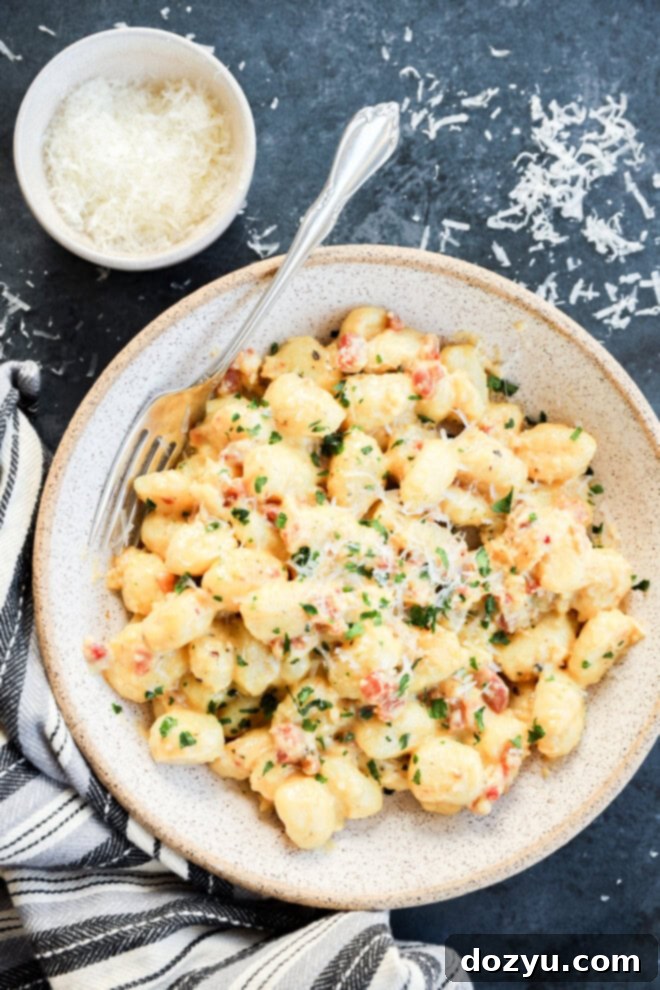
Expert Tips and Tricks for Perfect Carbonara
Mastering carbonara involves a few key techniques, especially when using gnocchi. These tips will help you achieve a restaurant-quality dish every time:
- Preventing a Scrambled Sauce is Key: The most common fear when making carbonara is scrambling the eggs. To avoid this, it’s paramount to remove the skillet from direct heat before incorporating the egg and cheese mixture. The residual heat from the gnocchi and the skillet is sufficient to gently cook the eggs into a creamy sauce without solidifying them. Additionally, always add the egg mixture gradually and stir continuously and vigorously. This prevents hot spots and ensures the eggs are evenly dispersed and emulsified, not cooked into clumps.
- Harness the Power of Residual Heat: The success of carbonara hinges on utilizing residual heat. If your skillet is too hot, the eggs will scramble instantly. If it’s too cool, the sauce won’t thicken. Removing the skillet from the burner after adding the starchy pasta water and before adding the eggs creates the ideal environment for a smooth, glossy sauce. If you find your sauce isn’t thickening enough, you can return the skillet to a very low heat for a few seconds, continuously stirring, but be extremely cautious.
- Add the Egg Sauce in Batches: Instead of dumping the entire egg mixture in at once, pour it into the gnocchi in two smaller batches. This allows for better control over the emulsification process. It gives you time to stir and assess the consistency, ensuring the sauce is evenly coated and lusciously smooth before adding more. This gradual approach is your best defense against a lumpy or scrambled sauce.
- Don’t Skimp on Freshly Grated Cheese: As mentioned in the ingredients section, freshly grated Pecorino Romano and Parmesan are essential. Pre-grated cheeses often contain cellulose, an anti-caking agent that can make your sauce gritty or prevent it from melting smoothly into a creamy emulsion. Freshly grated cheese melts beautifully, contributing to the rich texture and authentic flavor.
- Save Your Pasta Water: Never underestimate the power of starchy pasta water. It’s not just for thinning the sauce; the starches in the water help to create a smooth, cohesive emulsion with the egg and cheese, binding everything together. Always reserve more than you think you’ll need, as you can adjust the sauce’s consistency at the end.
- Serve Immediately: Carbonara is a dish that waits for no one. The moment it’s ready, it should be served. As it cools, the sauce will naturally thicken and can become clumpy. For the best experience, have your serving bowls ready and bring the dish directly to the table from the skillet.

Delicious Flavor Variations
While this Gnocchi Carbonara recipe is perfect as is, it’s also incredibly versatile. Feel free to experiment with these variations to suit your taste or what you have on hand:
- Pancetta Substitutions: If you can’t find pancetta, don’t despair! Guanciale (cured pork jowl) is the traditional choice for Roman carbonara and offers an even richer, more intense flavor. Alternatively, thick-cut bacon can be used. Simply dice three slices of thick-cut bacon and cook them as you would the pancetta. Bacon will lend a slightly smokier note to the dish, which can be a delicious twist.
- Adjust the Cheese Ratio: The blend of Pecorino Romano and Parmesan offers a balanced flavor profile, but you are the chef! For a sharper, more piquant taste, opt for all Pecorino Romano cheese. If you prefer a milder, nuttier flavor, use a higher ratio of Parmesan. Or, experiment with a 50/50 split, or a 75/25 split until you find your perfect cheesy balance. Freshly grated is always best for optimal melting and flavor.
- Add a Veggie Twist: Boost the nutritional content and add a splash of color by incorporating some vegetables. Fresh spinach or chopped kale can be stirred into the skillet in the last minute of cooking, just enough for them to wilt. Frozen peas can be added directly to the gnocchi boiling water during the last minute of cooking, then transferred with the gnocchi to the skillet. These additions offer a fresh contrast to the rich sauce.
- Spice Things Up: For those who appreciate a bit of heat, a pinch of red pepper flakes can be a wonderful addition. Stir them in along with the black pepper when the pancetta is crisping up. This allows the heat to infuse into the rendered fat, giving the dish a subtle warmth without overpowering the classic flavors. Start with a small amount and add more to your preference.
- Introduce Other Proteins: While not traditional, you could add other cooked proteins to make this dish even heartier. Cooked, shredded chicken, sautéed mushrooms, or even cooked shrimp could be folded in at the very end, just before serving, to warm through. If you opt for mushrooms, sauté them in a separate pan before adding to ensure they release their moisture and brown nicely.
More flavorful gnocchi recipes to try: Gnocchi Bolognese Bake I Baked Three Cheese Ricotta Gnocchi with Tomato Sauce I Brown Butter Gnocchi with Asparagus & Peas I Cheesy Pumpkin Gnocchi Bake

Can I use frozen gnocchi rather than store-bought gnocchi for this recipe?
Absolutely, yes! Frozen gnocchi is a perfectly acceptable and convenient option, especially when you’re looking to save time or if fresh gnocchi isn’t readily available. The key difference lies in the cooking instructions, which you’ll find on the package. Typically, frozen gnocchi will take a minute or two longer to cook than shelf-stable or refrigerated versions. Make sure to cook them according to the package directions until they float to the surface, indicating they are done. Once cooked, proceed with transferring them to the skillet with the pancetta as outlined in the recipe. The texture will remain beautifully tender and absorbent, just like the other types of gnocchi, making it an excellent base for our creamy carbonara sauce.
Can I use other types of pasta instead of gnocchi?
While this recipe is specifically crafted to highlight the unique, tender texture of potato gnocchi within a carbonara sauce, you can certainly substitute it with your favorite type of pasta if gnocchi isn’t your preference or simply unavailable. Classic carbonara is traditionally made with long, thin pasta like spaghetti, bucatini, or rigatoni, so any of these would be excellent choices. Shorter pasta shapes such as penne or farfalle also work well as they have nooks and crannies to capture the rich sauce. Keep in mind that cooking times will vary significantly depending on the pasta type, so always follow the package instructions for al dente perfection. Also, be aware that the overall texture and mouthfeel of the dish will be different from using gnocchi, but the delicious carbonara sauce will still shine through, coating whatever pasta you choose.
Need some inspiration for dinner? Check out my pasta recipes page!
What to Serve with This Gnocchi Carbonara
Gnocchi Carbonara is a rich and satisfying dish on its own, but pairing it with the right sides can create a perfectly balanced and unforgettable meal. Here are some complementary ideas:
- Crisp Green Salad: A simple, fresh, and lemony arugula salad is an ideal companion. Its peppery bite and bright, acidic dressing (a vinaigrette with lemon juice, olive oil, salt, and pepper) provide a refreshing contrast that cuts through the richness of the carbonara, cleansing the palate with each bite.
- Garlic Bread or Crostini: You can never go wrong with garlic bread when serving a pasta dish! It’s a classic crowd-pleaser that allows you to soak up every last drop of that incredible carbonara sauce. Elevate your garlic bread experience with an Air Fryer Roasted Garlic Bread recipe, or opt for some rustic sourdough garlic toast for an extra layer of flavor and texture.
- Steamed or Roasted Vegetables: Lightly steamed asparagus, green beans, or broccoli florets can add a healthy and vibrant element to your meal. Roasting them with a drizzle of olive oil, salt, and pepper will bring out their natural sweetness and offer a pleasant textural variation.
- A Good Italian Wine: To complete the experience, choose a wine that complements the richness of the carbonara without overpowering it. A light-bodied Italian red like a Chianti or a bright, crisp white wine such as a Pinot Grigio or Vermentino would pair beautifully. These wines offer acidity that balances the savory, cheesy flavors of the dish.
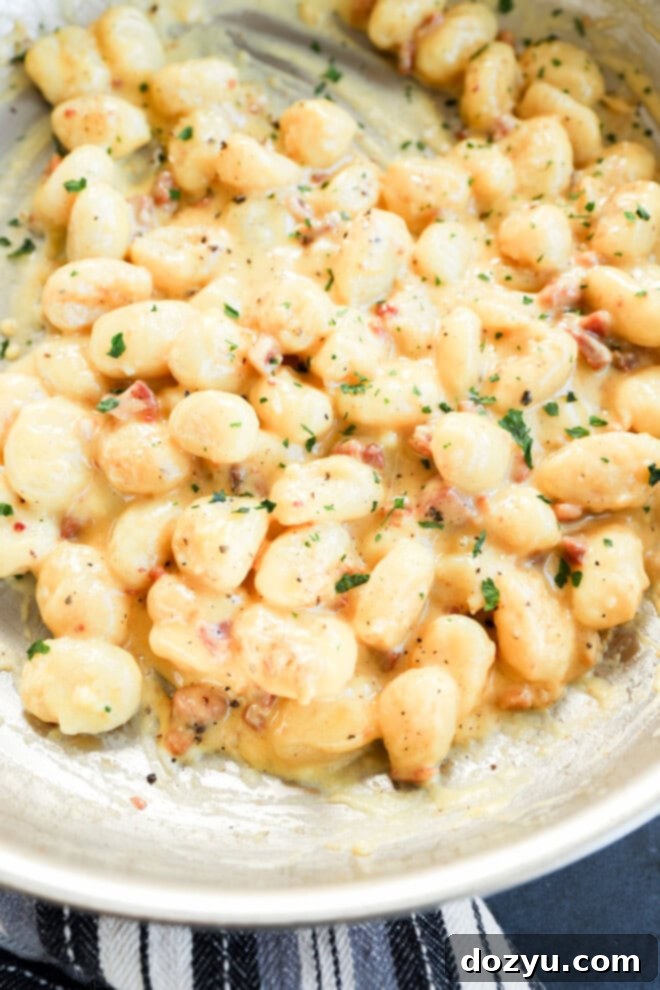
Storage and Reheating Tips
While Gnocchi Carbonara is definitely best enjoyed fresh off the stove, you might find yourself with a delightful serving or two left over. Here’s how to properly store and reheat your leftovers to maintain their deliciousness:
- Short-Term Storage (Refrigeration): If you have any leftovers, allow the dish to cool completely to room temperature first. Then, transfer them to an airtight container and refrigerate promptly. Properly stored, your Gnocchi Carbonara will remain fresh and flavorful for up to 3 days in the refrigerator. Beyond this, the quality will start to decline, particularly the texture of the sauce and gnocchi.
- Reheating Leftovers: The key to reheating carbonara is gentle heat to prevent the sauce from breaking or the eggs from scrambling.
- Stovetop Method (Recommended): Place the leftovers in a nonstick skillet over very low heat. As the gnocchi and sauce warm, the sauce will likely appear quite thick. To revive its creamy texture, add a splash (1-2 tablespoons) of water, chicken stock, or even a little milk/cream, stirring constantly until the sauce loosens and becomes glossy again. Continue stirring gently until the dish is heated through. Avoid high heat, as this can cause the eggs to curdle.
- Microwave Method: While less ideal for preserving texture, you can microwave leftovers. Place the gnocchi in a microwave-safe dish and heat in short bursts (30-60 seconds) on medium power, stirring well after each interval. You may need to add a small amount of liquid (water or stock) to help rehydrate the sauce. Be careful not to overheat.
Keep in mind that the texture of the gnocchi might be slightly softer, and the sauce may not be quite as perfectly emulsified as when it was freshly made. However, with careful reheating, it will still be incredibly tasty!
- Freezing is Not Recommended: Unfortunately, carbonara does not freeze well. The egg and cheese-based sauce tends to separate and lose its smooth, creamy quality when thawed and reheated, resulting in a grainy or curdled texture. The gnocchi can also become mushy after freezing and thawing. For the best culinary experience, enjoy this dish fresh or within a few days of refrigeration.
More of Our Favorite Gnocchi Dishes
If you’ve fallen in love with the tender, versatile world of gnocchi through this Carbonara, you’ll be thrilled to discover other incredible ways to enjoy these delightful potato dumplings. Gnocchi’s ability to absorb flavors and provide a comforting texture makes it a star in many dishes. Here are a few more of our go-to gnocchi recipes that you absolutely must try:
- Gnocchi Bolognese Bake is the ultimate cozy, cheesy, and saucy comfort food mashup. Imagine tender, pillowy gnocchi smothered in a rich, hearty meat bolognese sauce, then baked to bubbly, golden-brown perfection with a generous layer of melted cheese on top. It’s pure indulgence!
- Brown Butter Gnocchi with Asparagus and Peas offers a lighter yet equally flavorful experience. This elegant dish features perfectly pan-seared gnocchi tossed in a fragrant brown butter sauce, complemented by vibrant green asparagus and sweet peas. A squeeze of fresh lemon and a sprinkle of Parmesan finish this bright and inviting meal.
- Cheesy Pumpkin Gnocchi Bake brings autumnal warmth to your table. This recipe combines a creamy, spiced pumpkin sauce with tender gnocchi and plenty of melty cheese, all baked together into a golden, bubbly dish that’s both comforting and incredibly satisfying.
Finally, if you make this Gnocchi Carbonara recipe, please be sure to give this recipe a star recipe rating on the recipe card and/or leave a comment! Your feedback is incredibly valuable, and I truly love to hear when you all make my recipes. I make an effort to respond to every single comment and question. Feel free to drop questions below too, if you have them!
Oh, and be sure to tag me on Instagram, Facebook, or Pinterest if you make the recipe! I absolutely love being able to see these recipes come to life in your homes – it’s genuinely my favorite thing to look through those photos. It really means the world to me!
Want to know when I come out with a new recipe or the latest news? Sign up for my newsletter to get them straight to your inbox!
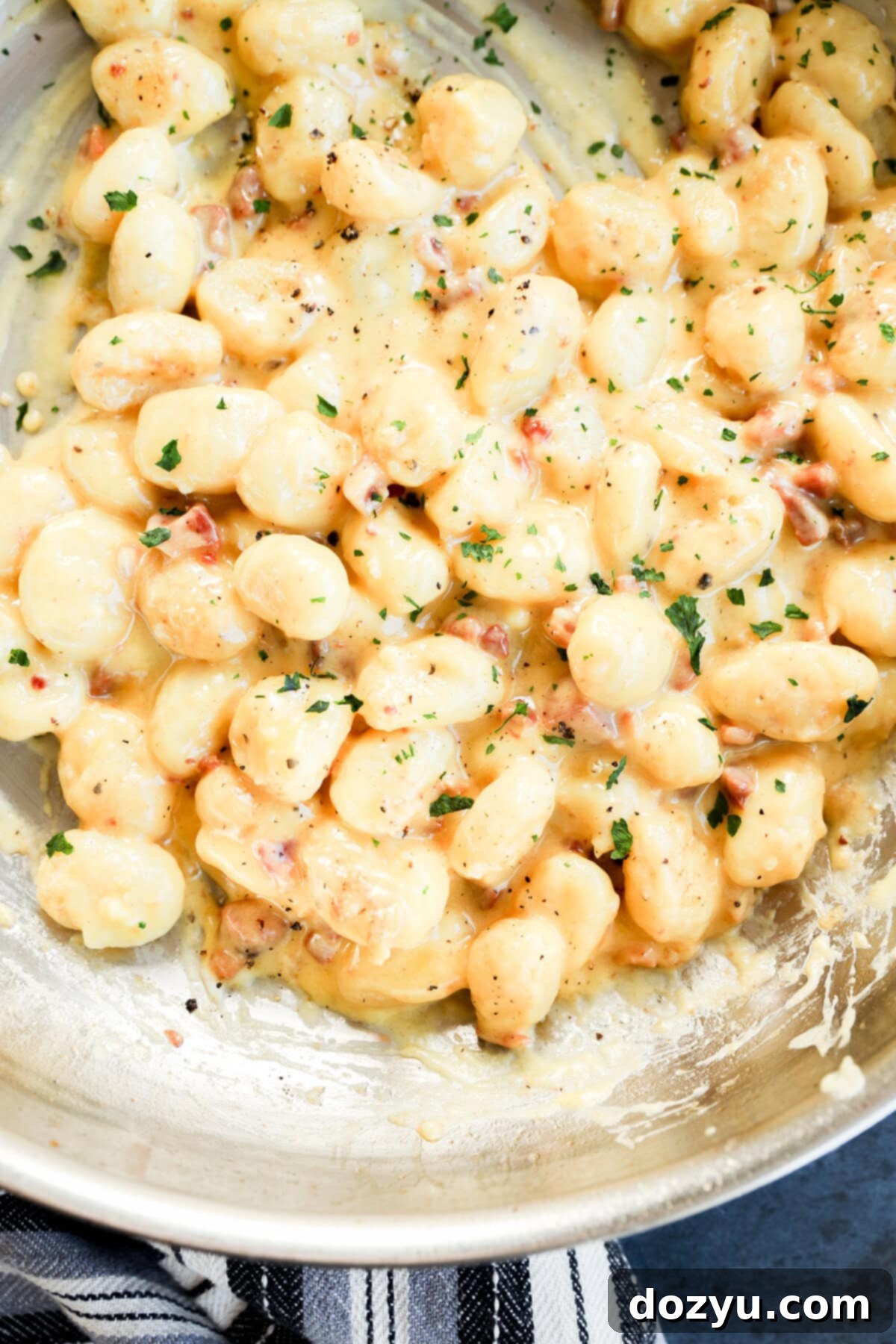
Gnocchi Carbonara
Equipment
-
large nonstick or cast iron skillet
-
wooden spoon
-
chef’s knife and cutting board
-
mixing bowls
-
spider strainer or slotted spoon
Ingredients
- 4 oz diced pancetta (about 3/4 cup)
- ¾ tsp coarsely ground black pepper (plus more for serving)
- 1 lb shelf-stable or refrigerated potato gnocchi
- 1 tsp kosher salt (for gnocchi water)
- 1 large egg
- 1 large egg yolk
- ¾ oz pecorino romano cheese (finely grated, about 1/2 cup)
- ½ oz parmesan cheese (finely grated, about 1/3 cup)
- Freshly chopped parsley or chives (for garnish, optional)
- Extra grated parmesan cheese (for garnish, optional)
Instructions
-
Bring a large pot of salted water to a boil over medium-high heat. Meanwhile, in a large nonstick skillet over medium heat, add the diced pancetta. Cook for 2-4 minutes until fat begins to render.
-
Reduce heat to medium-low and continue cooking the pancetta, stirring occasionally, for 6-8 minutes until it is crispy and browned. Stir in the coarse ground black pepper during the last minute of cooking.
-
Once the pancetta is crisp, add the gnocchi to the boiling water. Cook according to package directions, typically 2-3 minutes, until the gnocchi float to the surface.
-
Using a spider strainer or slotted spoon, transfer the cooked gnocchi directly from the pot to the skillet with the crispy pancetta and its drippings. Do not drain the pasta water; reserve about 1-1.5 cups for the sauce. Sauté the gnocchi in the pancetta drippings for 1-2 minutes, stirring to coat evenly. Stir in 1/3 cup of the reserved gnocchi cooking water and immediately remove the skillet from the heat.
-
In a medium bowl, whisk together the large egg, egg yolk, Pecorino Romano, and Parmesan cheese until well combined and smooth.
-
While continuously stirring the gnocchi with a wooden spoon, gradually add the egg and cheese mixture to the skillet in two batches. Stir vigorously to prevent the eggs from scrambling and to create a smooth, glossy sauce.
-
The residual heat in the pan should be enough to cook the sauce gently. If the sauce seems too thick, add more gnocchi cooking water, 1 tablespoon at a time, stirring constantly until the desired creamy consistency is achieved. Taste and adjust seasoning as needed. Garnish with fresh parsley or chives and serve immediately.
Video
Notes
- Pancetta Substitute: If you can’t find pancetta, 4 ounces (approximately 3 slices) of thick-cut bacon, diced, works as a flavorful alternative.
- Bacon Preparation: For best results, cut the bacon into 1/2-inch wide pieces before cooking.
- Cheese Quality: Always use freshly grated Pecorino Romano and Parmesan cheese. Pre-grated cheeses may contain anti-caking agents that can prevent the sauce from melting smoothly and achieving the desired creamy texture.
- Room Temperature Eggs: For the smoothest sauce, ensure your eggs are at room temperature before whisking them. This helps prevent them from seizing or scrambling when introduced to the warm gnocchi.
